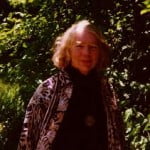by Thelma B. Freedman
 Two cases of past-life report therapy were closely examined in an attempt to test the hypothesis that this form of therapy can be effective with two very different types of presenting problems. The first was of a woman with a lifelong phobia for caterpillars; the second was of a dependent woman who suffered from severe attacks of anxiety and panic when confronted with a need to act independently. A number of sub-hypotheses were also tested. Based upon ten years of experience in past-life report therapy, I suspected that 1) no strong effect was necessary for successful outcome; 2) no therapist’s interpretation of reported events or themes was necessary as the reported events and themes would be non-symbolic and easily understood; 3) no lengthy preparation for therapy was necessary; and 4) no “protection” mechanism, such as visualized white light or spirit guardian, was necessary.
Two cases of past-life report therapy were closely examined in an attempt to test the hypothesis that this form of therapy can be effective with two very different types of presenting problems. The first was of a woman with a lifelong phobia for caterpillars; the second was of a dependent woman who suffered from severe attacks of anxiety and panic when confronted with a need to act independently. A number of sub-hypotheses were also tested. Based upon ten years of experience in past-life report therapy, I suspected that 1) no strong effect was necessary for successful outcome; 2) no therapist’s interpretation of reported events or themes was necessary as the reported events and themes would be non-symbolic and easily understood; 3) no lengthy preparation for therapy was necessary; and 4) no “protection” mechanism, such as visualized white light or spirit guardian, was necessary.
Method
Each client had individual sessions, with one past life being explored in each session. At their first sessions I established, by asking their “inner minds” while they were in hypnosis, the number of supposed past lives that must be examined, and thus the number of sessions we would need. According to their “inner minds,” the phobic client had “lived” a total of 20 past lives, of which only four had contributed to her phobia. The dependent client had lived 14 past lives, all of which has been instrumental in her dependency problems. Thus, for the phobic client we explored only those four that were relevant to her phobia, looking for specific events that were phobia-related. For the dependent client, we explored all 14 of her reported past lives, looking for themes and patterns rather than specific events.
At no time did I give suggestions of protective surroundings, light, or of spirit guardians. We simply went back into the life to be explored that day and examined it, situation by situation. I gave calming suggestions at the outset and during the report as necessary, keeping affect levels low. After the client was aroused from hypnosis we discussed the reports, and interpretations came from the client, not the therapist. All events and situations reported were straightforward, plausible, and seemed non-symbolic.
Results
After four sessions, the phobic client no longer feared caterpillars; instead, she ignored them. Her four reports followed a “phobic pattern” that I have found common in other phobic clients’ reports, and into which I am continuing research. She reported five negative events involving caterpillars and one involving maggots within four supposed past lives. One of these events was a death experience and one occurred in her most recent supposed past life, that is, the life immediately before her present life. In one of these events, she (or, he, in that life), was badly burned when a flaming web of tent caterpillars fell on her (his) back; this client has a three-inch-long birthmark on her back in the same place that the tent fell. This finding supports Stevenson’s (1966) findings of connections between birthmarks and claimed prior lives.
 In the case of the dependent client, after her 14 sessions she felt more comfortable in situations requiring independent action, and was able to give a short required speech in one of her classes and enjoy it. Her past-life reports contained the expected themes of dependency and helplessness but also themes of successful independence and ability. Dependency and helplessness had often led to death, but independence had too, so the conflict between these two opposing themes may have been the core of her problem.
In the case of the dependent client, after her 14 sessions she felt more comfortable in situations requiring independent action, and was able to give a short required speech in one of her classes and enjoy it. Her past-life reports contained the expected themes of dependency and helplessness but also themes of successful independence and ability. Dependency and helplessness had often led to death, but independence had too, so the conflict between these two opposing themes may have been the core of her problem.
I made no attempt to elicit her 14 past-life reports in their historically chronological order, so they emerged in a random order. For example, at her first session, her 13th past life emerged, and at her last session, her fifth. At that last session, however, I directed her (while still in hypnosis) to review them all and she herself arranged them chronologically and visualized them symbolically as a tree. She saw the first eight lives as comprising a sturdy trunk for her tree but said that in subsequent lives she had become too “specialized.” She had lost her “sturdiness” and become too “sensitive” to feelings and negative possibilities, in fact, looking at her reports in chronological order, one can see the increasing complexities of civilization itself presenting her with new dilemmas and taking their toll. Her 14 reports span 2000 years, four continents, three races, nine male and five female lives, and an unknown variety of religious beliefs. When her 14 reports are examined in their historically chronological order, a growth process becomes evident which moves from simplicity to great complexity of personality. This very complexity may reflect both the loss of “sturdiness” and the increase of sensitivity which made her vulnerable to the anxieties of independence. I should note that no recognizably “karmic” patterns can be discerned, at least not according to any traditional definition of karma.
At a four-year follow-up, neither client has had a return of her symptoms or developed any others.
Conclusion
If past-life reports are veridical (or partly veridical) reincarnation memories, then the model of psychology most strongly supported is the behaviorist one. In a sense, past-life reports show us conditioning in action, over many lifetimes rather than only one. This seems clear in phobia cases, where the phobia develops through repeated aversive exposure to the phobic stimulus. In the case of the dependent client this is also true, but in her case a new element emerges, because we examined all of her supposed past lives. This is the pattern of increasing personality complexity over centuries, clear when all of her 14 past lives are examined chronologically. This developing complexity is reminiscent of humanistic and transpersonal psychologies, especially the theories of Amerikaner (1981), Bugental (1978), and Wilber (1980).
If past-life reports are fantasies, behaviorist conditioning cannot explain them. Also, in the present case, at least, if the reports are fantasies, humanistic or transpersonal theories cannot explain the pattern of increasing complexity of personality of the 14-life series, because the reports were not elicited chronologically but rather in a random order. It is only when they are arranged in their chronological order that the patterns appears, and this was done by the client herself at her last session. One would not expect this patterning if the reports are fantasies. I am not sure if a similar pattern would appear in other complete series of one person’s reports, but in the one other complete series I have, a series of 16, it does.
In the present cases, high affect levels were not necessary, nor were suggestions about protective light or spirit guides. Lengthy advance preparations or interpretations from me were not necessary, either. We began at the first session and proceeded through the past-life reports session by session. That this is a powerful therapy there can, I think, be no doubt However, we need to know how to use it effectively and parsimoniously for a wide variety of problems and clients, and for that we need controlled research in the methods that the many case studies in the literature have suggested may be useful.
References
Amerikaner, M. J. “Continuing theoretical confergence: A general systems theory perspective on personal growth and development,” Journal of Individual Psychology, 37, pp. 31-53, 1981.
Bugental, J. F. T. Psychotherapy and process, Menlo Park, CA: Addison-Wesley, 1978.
Stevenson, I. “Twenty cases suggestive of reincarnation,” Proceedings of the American Society for Psychical Research, 26, New York: American Society for Psychical Research, 1966.
Wilber, K. “The pre-trans fallacy,” Revision, 3, 20, pp. 5-43, 1980.
